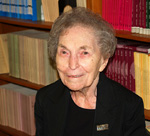Anna Schwartz
(1915 - 2012)

Anna Schwartz was an expert economist and brilliant academic who is best known for her collaboration with economist Milton Friedman, "A Monetary History of the United States 1867-1960". She was a prolific economic scholar and produced a large volume of work including nine books on monetary policy. She earned the titles of Distinguished Fellow at the American Economic Association and Fellow at the American Academy of Arts and Sciences. She recieved nine honorary degrees throughout her lifetime and was inducted into the National Women's Hall of Fame in 2013.
Schwartz was born on November 11 1915 in New York City and was the third of five children born to Eastern European immigrants Pauline and Hillel Jacobson. Schwartz had a knack for learning and graduated high school early, completing her undergraduate degree at women's liberal arts college Barnard College in 1934 when she was only eighteen. She then went on to complete her masters degree in economics from Columbia University during the next year.
After completing her masters degree at age nineteen, Schwartz entered the business world at Columbia University's Social Science Research Council. She married Isaac Schwartz in 1936 after the pair graduated from college together, and published her first paper "British Share Prices 1811-1850" in the 1940 edition of Review of Economics and Statistics. In 1941 she began working at the New York City branch of the National Bureau of Economic Research, where she would work for the rest of her life. Her business at the National Bureau of Economic Research originally focused on the study of business cycles. Schwartz completed her first major work in 1953, a collaboration between her, Arthur Gayer and Walt Whitman Rostow entitled "Growth and Fluctuations in the British Economy, 1790–1850: An Historical, Statistical, and Theoretical Study of Britain's Economic Development." The book came in two parts, was reprinted in 1975, and is still regarded by economic scholars as a seminal work of the period. It was here, at the National Bureau of Economic Research that Schwartz met Milton Friedman and his wife.
Anna Schwartz's work with famed economist and laureate Milton Friedman began in the 1940's and culminated with the publishing of their 900 page collaborative masterpiece "A Monetary History of the United States 1867-1960" in 1963. The book analyzed the monetary policy of the US government from Civil War reconstruction to the time of publication. At the time, the standard thought was that the 1929 stock market crash was the root cause of the Great Depression. Friedman and Schwartz made the case that the Federal Reserve severaly exacerbated the economic crisis of the 1930's also known as the Great Depression by not keeping the money supply steady and not acting as a "lender of last resort" following the massive bank failures and currency withdrawals that led to the Great Depression. In the book Friedman and Schwartz identified four major mistakes in monetary policy made by the Federal Reserve system that eventually led to the worst economic crisis in US history. Former Federal Reserve Chairman Ben Bernanke referred to A Monetary History of the United States 1867-1960 as "the leading and most persuasive explanation of the worst economic disaster in American history". At Milton Friedman's 90th birthday party in 2002 Bernanke stated that "I would like to say to Milton and Anna: Regarding the Great Depression, you’re right, we did it. We’re very sorry, but thanks to you we won’t do it again."
After the publication of A Monetary History of the United States 1867-1960, Schwartz completed her PHD in economics from Columbia University in 1964 at age fourty eight.
Along with Friedman she also published "Monetary Statistics of the United States" in 1970, and "Monetary Trends in the United States and the United Kingdom: Their Relation to Income, Prices, and Interest Rates, 1867–1975" in 1982.
Although Schwartz lived in New York and Friedman resided in Chicago, the two formed a close working relationship outlined by immense mutual respect. Friedman was quoted at one point saying that "Anna did all of the work, and I got most of the recognition". Anna Schwartz was credited as a co-author on many of the papers and work that led to Friedman's reciept of the 1976 Nobel Prize in Economic Science, and many people believe that the prize should have been awarded jointly to both of them. Anna remained largely in Friedman's shadow during her career and never quite recieved the recognition that she so rightfully deserved. According to Alan Meltzer, a professor of political economy at Carnegie Mellon University, "The fact that Anna never recieved any appointment at any major university is the clearest example I know of discrimination against women in the past."
In 1981 Schwartz took on her most public role as Executive Director of the United States Gold Commission, a 17 person panel tasked with exploring the future role of gold in the nation's monetary system and policies. She expressed no interest in returning to the gold standard and during her tenure there the panel's recommendations were limited to urging the government to mint gold coins.
She served as the President of the International Atlantic Economic Society from 2002-2003 and was elected a Fellow at the American Academy of Arts and Sciences in 2007.
Anna Schwartz died on June 21 2012 in her Manhattan home at age ninety six. She outlived her husband, who died in 1999, and is survived by four children, seven grandchildren, and six great-grandchildren.
Sources:New York Times (June 22 2012), Bloomberg (June 21 2012), Wikipedia, Policonomics.com, National Bureau of Economic Research (October 2007), The New School,
Wikimedia, By David Shankbone (Own work) [GFDL (http://www.gnu.org/copyleft/fdl.html) or CC-BY-SA-3.0-2.5-2.0-1.0 (http://creativecommons.org/licenses/by-sa/3.0)], via Wikimedia Commons


